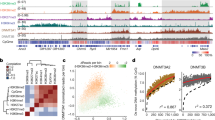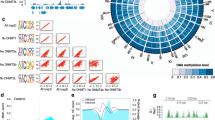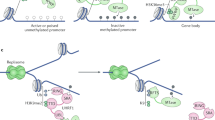Abstract
The nucleotide 5-methylcytosine is involved in processes crucial in mammalian development, such as X-chromosome inactivation and gene imprinting1,2,3,4,5. In addition, cytosine methylation has long been speculated to be involved in the establishment and maintenance of cell type–specific expression of developmentally regulated genes6,7; however, it has been difficult to identify clear examples of such genes, particularly in humans8. Here we provide evidence that cytosine methylation of the maspin gene (SERPINB5) promoter controls, in part, normal cell type–specific SERPINB5 expression. In normal cells expressing SERPINB5, the SERPINB5 promoter is unmethylated and the promoter region has acetylated histones and an accessible chromatin structure. By contrast, normal cells that do not express SERPINB5 have a completely methylated SERPINB5 promoter with hypoacetylated histones, an inaccessible chromatin structure and a transcriptional repression that is relieved by inhibition of DNA methylation. These findings indicate that cytosine methylation is important in the establishment and maintenance of cell type–restricted gene expression.
This is a preview of subscription content, access via your institution
Access options
Subscribe to this journal
Receive 12 print issues and online access
$209.00 per year
only $17.42 per issue
Buy this article
- Purchase on Springer Link
- Instant access to full article PDF
Prices may be subject to local taxes which are calculated during checkout






Similar content being viewed by others
References
Li, E., Bestor, T.H. & Jaenisch, R. Targeted mutation of the DNA methyltransferase gene results in embryonic lethality. Cell 69, 915–926 (1992).
Li, E., Beard, C. & Jaenisch, R. Role for DNA methylation in genomic imprinting. Nature 366, 362–365 (1993).
Gartler, S.M. & Riggs, A.D. Mammalian X-chromosome inactivation. Annu. Rev. Genet. 17, 155–190 (1983).
Beard, C., Li, E. & Jaenisch, R. Loss of methylation activates Xist in somatic but not in embryonic cells. Genes Dev. 9, 2325–2334 (1995).
Venolia, L. et al. Transformation with DNA from 5-azacytidine-reactivated X chromosomes. Proc. Natl Acad. Sci. USA 79, 2352–2354 (1982).
Riggs, A.D. X inactivation, differentiation, and DNA methylation. Cytogenet. Cell Genet. 14, 9–25 (1975).
Holliday, R. & Pugh, J.E. DNA modification mechanisms and gene activity during development. Science 187, 226–232 (1975).
Walsh, C.P. & Bestor, T.H. Cytosine methylation and mammalian development. Genes Dev. 13, 26–34 (1999).
Zhang, M., Magit, D. & Sager, R. Expression of maspin in prostate cells is regulated by a positive ets element and a negative hormonal responsive element site recognized by androgen receptor. Proc. Natl Acad. Sci. USA 94, 5673–5678 (1997).
Zou, Z. et al. Maspin, a serpin with tumor-suppressing activity in human mammary epithelial cells. Science 263, 526–529 (1994).
Czerwenka, K.F. et al. Comparative analysis of two-dimensional protein patterns in malignant and normal human breast tissue. Cancer Detect. Prev. 25, 268–279 (2001).
Maass, N. et al. Down regulation of the tumor suppressor gene maspin in breast carcinoma is associated with a higher risk of distant metastasis. Clin. Biochem. 34, 303–307 (2001).
Domann, F.E., Rice, J.C., Hendrix, M.J. & Futscher, B.W. Epigenetic silencing of maspin gene expression in human breast cancers. Int. J. Cancer 85, 805–810 (2000).
Zhang, M., Maass, N., Magit, D. & Sager, R. Transactivation through Ets and Ap1 transcription sites determines the expression of the tumor-suppressing gene maspin. Cell Growth Differ. 8, 179–186 (1997).
Gardiner-Garden, M. & Frommer, M. CpG islands in vertebrate genomes. J. Mol. Biol. 196, 261–282 (1987).
Ioshikhes, I.P. & Zhang, M.Q. Large-scale human promoter mapping using CpG islands. Nature Genet. 26, 61–63 (2000).
Larsen, F., Gundersen, G., Lopez, R. & Prydz, H. CpG islands as gene markers in the human genome. Genomics 13, 1095–1107 (1992).
Antequera, F. & Bird, A. Number of CpG islands and genes in human and mouse. Proc. Natl Acad. Sci. USA 90, 11995–11999 (1993).
Zou, Z. et al. p53 regulates the expression of the tumor suppressor gene maspin. J. Biol. Chem. 275, 6051–6054 (2000).
Jones, P.A. & Taylor, S.M. Cellular differentiation, cytidine analogs and DNA methylation. Cell 20, 85–93 (1980).
Jones, P.A. & Laird, P.W. Cancer epigenetics comes of age. Nature Genet. 21, 163–167 (1999).
Baylin, S.B., Herman, J.G., Graff, J.R., Vertino, P.M. & Issa, J.P. Alterations in DNA methylation: a fundamental aspect of neoplasia. Adv. Cancer Res. 72, 141–196 (1998).
Baylin, S.B. & Herman, J.G. DNA hypermethylation in tumorigenesis: epigenetics joins genetics. Trends Genet. 16, 168–174 (2000).
Huang, Y. & Domann, F.E. Transcription factor AP-2 mRNA and DNA binding activity are constitutively expressed in SV40-immortalized but not normal human lung fibroblasts. Arch. Biochem. Biophys. 364, 241–246 (1999).
Johnson, G.K. & Organ, C.C. Prostaglandin E2 and interleukin-1 concentrations in nicotine-exposed oral keratinocyte cultures. J. Periodontal Res. 32, 447–454 (1997).
Kondo, M., Finkbeiner, W.E. & Widdicombe, J.H. Simple technique for culture of highly differentiated cells from dog tracheal epithelium. Am. J. Physiol. 261, L106–117 (1991).
Zabner, J., Zeiher, B.G., Friedman, E. & Welsh, M.J. Adenovirus-mediated gene transfer to ciliated airway epithelia requires prolonged incubation time. J. Virol. 70, 6994–7003 (1996).
Cody, D.T., Huang, Y., Darby, C.J., Johnson, G.K. & Domann, F.E. Differential DNA methylation of the p16 INK4A/CDKN2A promoter in human oral cancer cells and normal human oral keratinocytes. Oral Oncol. 35, 516–522 (1999).
Clark, S.J., Harrison, J., Paul, C.L. & Frommer, M. High sensitivity mapping of methylated cytosines. Nucleic Acids Res. 22, 2990–2997 (1994).
Rice, J.C. & Futscher, B.W. Transcriptional repression of BRCA1 by aberrant cytosine methylation, histone hypoacetylation and chromatin condensation of the BRCA1 promoter. Nucleic Acids Res. 28, 3233–3239 (2000).
Watts, G.S. et al. Methylation of discrete regions of the O6-methylguanine DNA methyltransferase (MGMT) CpG island is associated with heterochromatinization of the MGMT transcription start site and silencing of the gene. Mol. Cell. Biol. 17, 5612–5619 (1997).
Acknowledgements
We thank J. Munoz-Rodriguez and M. Fitzgerald for technical assistance. This work was supported by grants from the National Institutes of Health to B.W.F. and F.E.D. as well as to the Arizona Cancer Center and the Gene Therapy Center at the Univ. of Iowa. M.O. was supported by a Cancer Biology Training grant from the National Institutes of Health, R.W. received support from a Toxicology Training grant from the National Institute of Environmental Health Sciences, and H.D. received support from the Milheim Foundation for Cancer Research.
Author information
Authors and Affiliations
Corresponding author
Ethics declarations
Competing interests
The authors declare no competing financial interests.
Supplementary information
Rights and permissions
About this article
Cite this article
Futscher, B., Oshiro, M., Wozniak, R. et al. Role for DNA methylation in the control of cell type–specific maspin expression. Nat Genet 31, 175–179 (2002). https://doi.org/10.1038/ng886
Received:
Accepted:
Published:
Issue Date:
DOI: https://doi.org/10.1038/ng886
This article is cited by
-
Epigenome editing and epigenetic gene regulation in disease phenotypes
Korean Journal of Chemical Engineering (2022)
-
Unraveling the functional role of DNA demethylation at specific promoters by targeted steric blockage of DNA methyltransferase with CRISPR/dCas9
Nature Communications (2021)
-
Rapid Genomic and Epigenetic Alterations in Gynogenetic Carassius auratus Red Var. Derived from Distant Hybridization
Marine Biotechnology (2020)
-
DNA methylation of a NF-κB binding site in the aquaporin 5 promoter impacts on mortality in sepsis
Scientific Reports (2019)
-
Analysis on the Meiosis-Related Gene (Dmc1, Ph1) Expression in Autotriploid Carassius auratus
Marine Biotechnology (2019)



